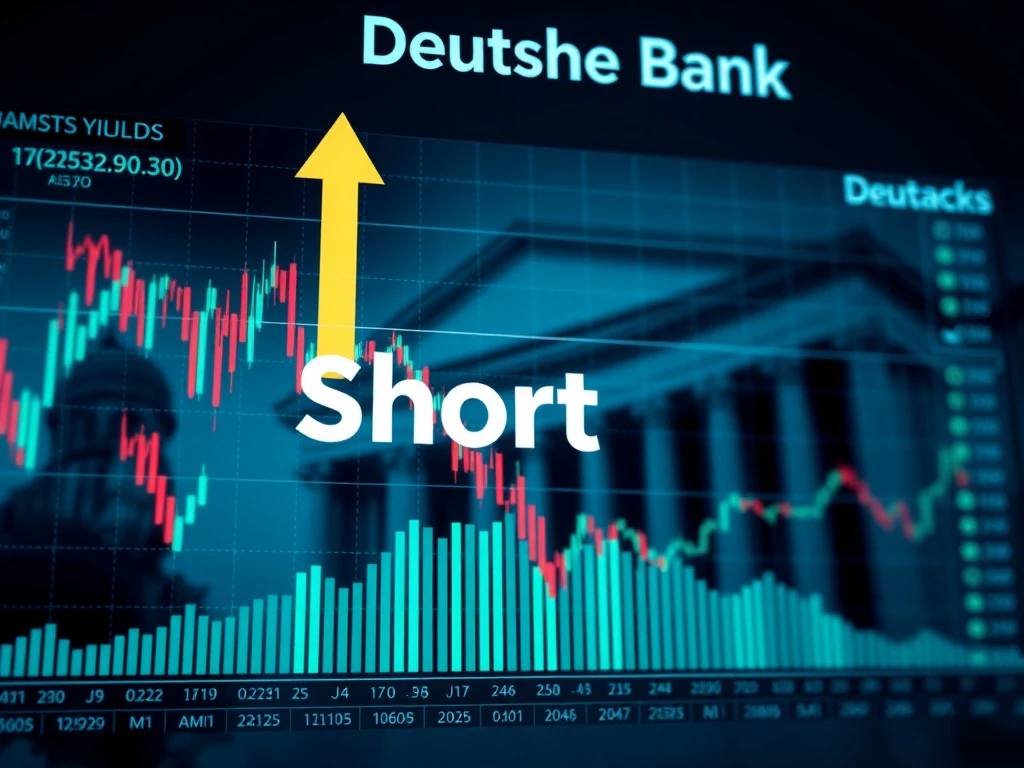Deutsche Bank recently issued a significant market call. They advise clients to **short the 10-year Treasury**. This bold move signals a potential shift in global financial markets. It carries substantial implications for investors worldwide. Understanding this recommendation requires a close look at current economic conditions. Furthermore, it involves assessing the outlook for interest rates and inflation. This article explores Deutsche Bank’s rationale in detail. It also examines the broader impact of such a strategy.
Understanding the Call: Why Short the 10-Year Treasury?
To short an asset means betting on its price decline. When investors **short the 10-year Treasury**, they anticipate its value will fall. Consequently, its yield would rise. Treasury bonds are debt instruments issued by the U.S. government. The **10-year Treasury** note is a benchmark for long-term interest rates. Its yield influences mortgages, corporate debt, and other financial products. A call to short this bond suggests expectations of higher inflation or more aggressive Federal Reserve actions. Therefore, bond prices would drop. Their yields would climb. This strategy aims to profit from that expected price depreciation.
Historically, bond prices and yields move inversely. When prices fall, yields rise. Conversely, when prices rise, yields fall. Deutsche Bank’s recommendation hinges on this fundamental relationship. They foresee conditions that will push bond prices lower. This perspective contrasts with a ‘long’ position. A long position profits from rising bond prices or falling yields. Shorting is generally a more complex and riskier strategy. It involves borrowing the asset, selling it, and then repurchasing it later at a lower price. This difference creates a profit. Losses can be unlimited if the asset’s price increases instead.
Deutsche Bank’s Rationale: Key Factors Driving the 10-Year Treasury Outlook
Deutsche Bank’s analysis points to several critical factors. These elements support their bearish outlook on the **10-year Treasury**. Firstly, persistent inflation remains a primary concern. Central banks globally have struggled to bring inflation back to target levels. Supply chain disruptions and strong consumer demand contribute to this pressure. Therefore, inflation could stay elevated longer than anticipated. This scenario erodes the purchasing power of fixed-income assets. It makes bonds less attractive. Investors then demand higher yields to compensate for this loss.
Secondly, the Federal Reserve’s policy path plays a crucial role. The Fed has signaled a commitment to fighting inflation. This commitment might involve keeping interest rates higher for longer. It could even include further rate hikes. Such actions directly impact bond yields. Higher policy rates typically translate to higher long-term bond yields. Consequently, this would drive down bond prices. Deutsche Bank believes the market may be underestimating the Fed’s resolve. This underestimation creates an opportunity for a short position. Thirdly, robust economic data in the U.S. also factors into their view. Strong employment figures and resilient consumer spending could fuel inflation. They might also give the Fed more room to maintain tight monetary policy. Ultimately, these combined forces underpin Deutsche Bank’s bearish stance on the **10-year Treasury**.
Historical Precedents and Bond Market Dynamics for the 10-Year Treasury
The bond market has seen similar cycles before. Understanding historical precedents offers valuable context. For instance, periods of high inflation in the 1970s led to significant bond market volatility. Yields soared as the Federal Reserve aggressively raised rates. This historical parallel highlights the potential for dramatic shifts in bond prices. More recently, the post-pandemic recovery saw a sharp rise in inflation. Bond yields also increased from their historic lows. However, the current environment presents unique challenges. Global debt levels are significantly higher. Geopolitical tensions also add to market uncertainty. These factors could amplify any bond market movements.
Bond market dynamics are complex. They involve a delicate balance of supply and demand. Government borrowing needs increase the supply of bonds. This can put downward pressure on prices. Investor demand, influenced by economic outlooks and interest rate expectations, affects the demand side. When demand wanes, yields rise. Deutsche Bank’s call suggests a supply-demand imbalance. They anticipate that demand for the **10-year Treasury** will decrease. This will happen as investors seek higher returns elsewhere. Or, they might demand greater compensation for inflation risk. Moreover, the unwinding of quantitative easing programs by central banks removes a major buyer from the market. This also contributes to higher yields.
Potential Risks and Rewards for Shorting the 10-Year Treasury
Shorting the **10-year Treasury** offers potential for substantial returns. However, it also carries significant risks. The primary reward comes from correctly anticipating a rise in yields. If bond prices fall as expected, investors can buy back the bonds at a lower price. This generates a profit. The leverage often used in short positions can magnify these gains. For example, a small price movement can lead to large profits. This potential attracts aggressive investors.
Conversely, the risks are considerable. Bond markets can be highly unpredictable. Unexpected economic data or a dovish shift by the Federal Reserve could cause yields to fall. This would lead to losses for short sellers. Unlike long positions, where losses are limited to the initial investment, theoretical losses on a short position are unlimited. If the bond price keeps rising, the short seller must eventually buy it back at an even higher price. Furthermore, carrying costs, such as borrowing fees, can erode profits. Market liquidity can also be a concern during periods of extreme volatility. Investors must manage these risks carefully. Therefore, this strategy is generally suitable for experienced market participants. It requires a deep understanding of macroeconomics and bond market mechanics.
Broader Implications for Global Financial Markets from the 10-Year Treasury Outlook
A sustained rise in **10-year Treasury** yields would ripple across global financial markets. Firstly, it would increase borrowing costs for governments and corporations. Higher Treasury yields serve as a benchmark. This means other debt instruments become more expensive to issue. Companies might delay expansion plans. Governments could face larger interest payments on their national debt. Secondly, equity markets could experience pressure. Higher bond yields make fixed-income investments more attractive relative to stocks. This can lead to a rotation of capital out of equities. Growth stocks, which rely on future earnings, are particularly vulnerable. Their valuations often suffer when discount rates rise.
Thirdly, currency markets would also react. A strong U.S. dollar often accompanies rising U.S. yields. This happens as global investors seek higher returns in dollar-denominated assets. This could put pressure on other currencies. It might also impact trade balances. Finally, emerging markets could face significant challenges. Many emerging economies have dollar-denominated debt. A stronger dollar and higher U.S. interest rates make servicing this debt more expensive. This can lead to capital outflows and financial instability. Ultimately, Deutsche Bank’s call, if realized, could trigger widespread adjustments across the global financial system.
Navigating the Market: Expert Insights and Investor Strategies for the 10-Year Treasury
Investors must consider various perspectives when evaluating Deutsche Bank’s call. Many analysts acknowledge the inflationary pressures. However, some believe that bond yields have already peaked. They point to signs of economic slowdown or potential disinflationary forces. Therefore, market consensus on the **10-year Treasury** remains divided. Investors should conduct their own thorough research. They must assess their risk tolerance. Diversification remains a key principle in portfolio management. Investors might consider reducing exposure to long-duration bonds. They could also explore inflation-protected securities. These bonds offer some defense against rising prices. Short-duration bonds might also be appealing. They are less sensitive to interest rate fluctuations.
Furthermore, alternative investments could provide diversification. Commodities, real estate, and certain equity sectors can perform well in inflationary environments. However, each asset class carries its own risks. Consulting with a financial advisor is always prudent. They can help tailor strategies to individual financial goals. Market conditions evolve rapidly. Staying informed about economic data, central bank statements, and geopolitical developments is crucial. Ultimately, a balanced approach, informed by expert analysis and personal financial circumstances, is advisable.
Deutsche Bank’s call to short the **10-year Treasury** represents a significant market view. It reflects concerns about persistent inflation and the Federal Reserve’s policy trajectory. While offering potential gains, this strategy also involves considerable risks. Its realization would have broad implications for bond, equity, and currency markets globally. Investors should carefully consider these factors. They must also weigh their own risk appetite before making any investment decisions. The coming months will reveal whether Deutsche Bank’s bold prediction comes to fruition, shaping the landscape of global finance.
Frequently Asked Questions (FAQs)
What does it mean to short the 10-year Treasury?
Shorting the **10-year Treasury** means an investor expects its price to fall. They borrow the bond, sell it, and then plan to buy it back at a lower price later. The difference between the selling price and the repurchase price, minus any costs, is their profit.
Why is Deutsche Bank recommending this strategy?
Deutsche Bank’s recommendation is based on their expectation of persistent inflation and a more aggressive Federal Reserve. They believe these factors will lead to higher interest rates and lower bond prices for the **10-year Treasury**.
What are the main risks of shorting Treasury bonds?
The main risks include potentially unlimited losses if bond prices rise unexpectedly. Additionally, borrowing costs can erode profits, and market volatility can make the strategy unpredictable. Unexpected economic shifts can also reverse the trend.
How would a rise in 10-year Treasury yields affect the broader market?
A rise in **10-year Treasury** yields would increase borrowing costs for governments and corporations. It could also make fixed-income investments more attractive than stocks, potentially leading to equity market pressure. Furthermore, it might strengthen the U.S. dollar and impact emerging markets.
Is shorting the 10-year Treasury suitable for all investors?
No, shorting the **10-year Treasury** is generally suitable for experienced investors. It requires a deep understanding of financial markets and a high tolerance for risk. Retail investors often find it too complex and risky for their portfolios.
What alternatives exist for investors concerned about rising yields?
Investors concerned about rising yields might consider inflation-protected securities (TIPS), short-duration bonds, or alternative investments like commodities or real estate. Diversification across various asset classes can also help mitigate risk.
















